|
CHIN'S NATURE CORNER ~ PHOTO GALLERY ~ WILD GINGERS
|
“Wild Gingers”
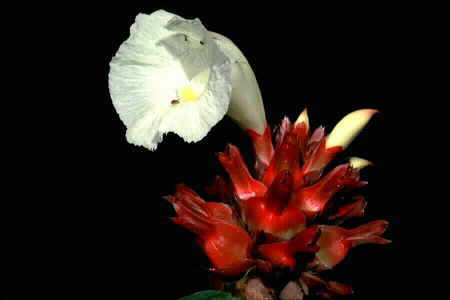 WILD GINGERS is a loose term that refers to plants of the ginger family (Zingiberaceae)
which grow in the wild. They are related to the true ginger (Zingiber officinale), as well as
cardamom (Elettaria cardamomum) and turmeric (Curcuma domestica),
which have been cultivated for ages and are used mainly as food
flavouring, and also for medicinal and other purposes. Certain 'wild gingers' are collected and used as food
flavouring and herbal remedies. Gingers have also gained the attention of horticulturists for their beautiful
flowers.
WILD GINGERS is a loose term that refers to plants of the ginger family (Zingiberaceae)
which grow in the wild. They are related to the true ginger (Zingiber officinale), as well as
cardamom (Elettaria cardamomum) and turmeric (Curcuma domestica),
which have been cultivated for ages and are used mainly as food
flavouring, and also for medicinal and other purposes. Certain 'wild gingers' are collected and used as food
flavouring and herbal remedies. Gingers have also gained the attention of horticulturists for their beautiful
flowers.
These are some of the 'wild gingers' that I have photographed during my
rambles in the jungle.
|
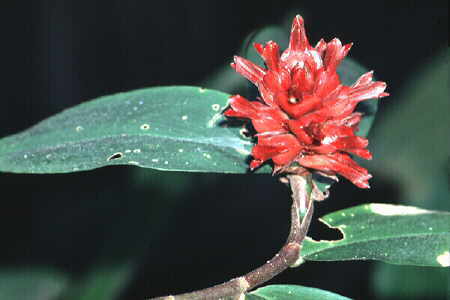
|
Costus speciosus
This ginger plant grows to a height of six to eight feet (roughly two metres), with long leaves
arranged in a sort of spiral. Known as “setawar” in the Malay language, it is used as
a herbal remedy for fever. The leaves are ground into a paste and applied to the forehead to bring
down a high fever.
|
|
Torch Ginger (Etlingera elatior)
The fully-grown flower bud of this ginger is eaten raw as a salad or used as food flavouring,
especially in “laksa” (rice noodles in a spicy, fish soup). Known locally as
“bunga kantan”, the flower buds were previously collected from the forest for
the market, but the torch ginger is now cultivated.
|

|

|
Globba species, possibly G. pattens
The flowers of some species in the genus Globba are quite showy, and are
called Dancing Ladies. The inflorescences resemble the orchids with a similar
name. The species pictured here was photographed in a shady area in secondary
forest.
|
|
Food for butterflies
The flowers of this ginger resemble orchids. They are also a source of nectar
for butterflies and other insects. I was not able to find out the name of this species,
but the flowers resemble those of a species of Alpinia, another genus of
ginger plants.
|
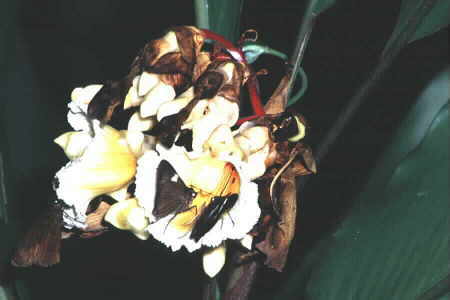
|

|
Etlingera punicea
The striking flowers of this ginger grows out of the soil and contrasts sharply
with the drab colours of forest floor detritus. Sometimes you may have to sweep away
the dead leaves to fully admire the blooms. Etlingera punicea is one of the most common
“earth gingers” in Peninsular Malaysia.
|
|
Etlingera littoralis
This is another common 'earth ginger' with flowers that grow out of the ground.
I photographed this specimen in semi-shade at the fringe of a secondary forest.
Etlingera littoralis is widespread in Peninsular Malaysia and is also found in
Singapore, Thailand and Sumatra.
|

|
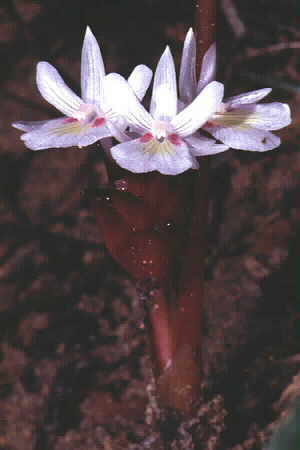
|
Elettariopsis?
The flowers of this ginger are very small, less than 2cm across (less than
one inch), and look like white orchids. The plant grows in damp, well-shaded
areas near rivers. I have not been able to find out the name of this
species, but the flowers slightly resemble those of Elettariopsis triloba.
|
|
The Black Gingerwort
(Zingiber spectabile)
The plant can grow to a height of seven feet (about 2m) and the flower stalk
with the inflorescence can be as tall as three feet (less than a metre). Recently, I saw stalks
of the flower for sale at a florist's. Known locally as “tepus tanah”, it is grown
in villages for use in traditional medicine.
|
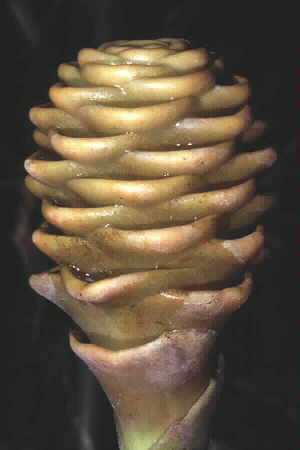
|

|
Flower Power
The inflorescence of this ginger plant look pretty even though the flowers are yet to blossom.
It shows the potential of this species as a garden flower. This could be a species
of Hedychium.
|
This page revised on 24 May 2004. Copyright © Chin Fah Shin.
|
|
You can support this
site by shopping at AllPosters.com
|

|
Please click on a link below to shop online
|

